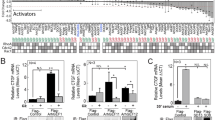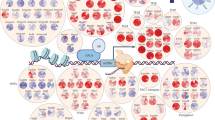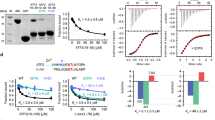Abstract
A FEW general transcription factors, in particular TFIID and TFIIB, have been found to bind transcriptional activators1. Here we show that the general transcription factor TFIIF is also a target for a transcriptional activator, namely serum response factor (SRF), which binds to the c-fos promoter. Using a yeast interaction assay, we find that SRF binds the RAP74 subunit of TFIIF and that SRF's transcriptional activation domain is the region involved in this binding. Further, RAP74's central charged cluster domain is required for binding to SRF's activation domain. Deletion of this domain impairs RAP74's ability to support SRF-activated transcription in vitro but has little effect on the protein's basal transcription activity or its ability to support SP1-activated transcription. The correlation of SRF–RAP74 binding with transcriptional activation suggests that RAP74 is a critical target for SRF-activated transcription.
This is a preview of subscription content, access via your institution
Access options
Subscribe to this journal
Receive 51 print issues and online access
$199.00 per year
only $3.90 per issue
Buy this article
- Purchase on Springer Link
- Instant access to full article PDF
Prices may be subject to local taxes which are calculated during checkout
Similar content being viewed by others
References
Tjian, R. & Maniatis, M. Cell 77, 5–8 (1994).
Zhu, H., Joliot, V. & Prywes, R. J. biol. Chem. 269, 3489–3497 (1994).
Dalton, S. & Treisman, R. Cell 68, 597–612 (1992).
Prywes, R. & Zhu, H. Nucleic Acids Res. 20, 513–520 (1992).
Johansen, F.-E. & Prywes, R. Molec. cell. Biol. 13, 4640–4647 (1993).
Lee, T.-C., Shi, Y. & Schwartz, R. J. Proc. natn. Acad. Sci. U.S.A. 89, 9814–9818 (1992).
Hill, C. S. et al. Cell 73, 395–406 (1993).
Liu, S.-H. et al. J. biol. Chem. 268, 21147–21154 (1993).
Mueller, C. G. F. & Nordheim, A. EMBO J. 10, 4219–4229 (1991).
Shaw, P. E. EMBO J. 11, 3011–3019 (1992).
Johansen, F.-E. & Prywes, R. Molec. cell. Biol. 14, 5920–5928 (1994).
Yonaha, M. et al. Nucleic Acids Res. 21, 273–279 (1993).
Finkelstein, A. et al. Nature 355, 464–467 (1992).
Aso, T. et al. Nature 355, 461–464 (1992).
Flores, O. et al. Proc. natn. Acad. Sci. U.S.A. 88, 9999–10003 (1991).
Kim, Y.-J., Bjorklund, S., Li, Y., Sayre, M. H. & Kornberg, R. D. Cell 77, 599–608 (1994).
Koleske, A. J. & Young, R. A. Nature 386, 466–469 (1994).
Flores, O., Maldonado, E. & Reinberg, D. J. biol. Chem. 264, 8913–8921 (1989).
Price, D. H., Sluder, A. E. & Greenleaf, A. L. Molec. cell. Biol. 9, 1465–1475 (1989).
Bengal, E., Flores, O., Krauskopf, A., Reinberg, D. & Aloni, Y. Molec. cell. Biol. 11, 1195–1206 (1991).
Chang, C.-h., Kostrub, C. F. & Burton, Z. F. J. biol. Chem. 268, 20482–20489 (1993).
Fields, S. & Song, O.-K. Nature 340, 245–246 (1989).
Wang, B. Q., Kostrub, C. F., Finkelstein, A. & Burton, Z. F. Protein Expr. Purif. 4, 207–214 (1993).
Author information
Authors and Affiliations
Rights and permissions
About this article
Cite this article
Joliot, V., Demma, M. & Prywes, R. Interaction with RAP74 subunit of TFIIF is required for transcriptional activation by serum response factor. Nature 373, 632–635 (1995). https://doi.org/10.1038/373632a0
Received:
Accepted:
Issue Date:
DOI: https://doi.org/10.1038/373632a0
This article is cited by
-
Characteristics of the CArG-SRF binding context in mammalian genomes
Mammalian Genome (2010)
-
Interaction with general transcription factor IIF (TFIIF) is required for the suppression of activated transcription by RPB5-mediating protein (RMP)
Cell Research (2003)
-
Structure of serum response factor core bound to DNA
Nature (1995)
Comments
By submitting a comment you agree to abide by our Terms and Community Guidelines. If you find something abusive or that does not comply with our terms or guidelines please flag it as inappropriate.



